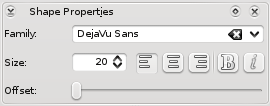Karbon/Tutorials/Artistic Text Shape/fr: Difference between revisions
ChristianW (talk | contribs) Created page with "{{Tip|Si un docker n'est pas visible, vous pouvez soit aller sur le menu <menuchoice>Configuration-> Dockers</menuchoice> , ou cliquez-droit sur un titre de docker, et ensuite..." |
ChristianW (talk | contribs) Created page with "Après avoir changé la <menuchoice>police</menuchoice> en "Steve", mis la <menuchoice>taille</menuchoice> à 30 points, et la fonte en <menuchoice>gras</menuchoice>, vous pou..." |
||
| Line 22: | Line 22: | ||
|} | |} | ||
Après avoir changé la <menuchoice>police</menuchoice> en "Steve", mis la <menuchoice>taille</menuchoice> à 30 points, et la fonte en <menuchoice>gras</menuchoice>, vous pouvez observer la forme suivante dans votre canevas : | |||
[[Image:Cool-artistic-text-shape.png|center]] | [[Image:Cool-artistic-text-shape.png|center]] | ||
Revision as of 09:53, 6 March 2018
Ce tutoriel présente ce que l'on peut faire avec les . Bien que ce tutoriel ait été fait avec Karbon, les formes sont disponibles dans les autres applications Calligra, et fonctionnent de la même façon.
Dans cette leçon, vous allez
- créer une forme avec un texte
- associer une forme à un chemin
Premier pas avec une forme textuelle
 |
Pour ajouter une forme textuelle artistique, reportez-vous au docker , cliquez sur l'icône , et déplacez-la sur le canevas. |
After adding the shape, you might want to edit the text and display something more interesting. To do this, you need to activate the , either by double clicking on the newly created shape, or selecting  in the toolbox. Then you can change the text to something like this.
in the toolbox. Then you can change the text to something like this.

Après avoir changé la en "Steve", mis la à 30 points, et la fonte en , vous pouvez observer la forme suivante dans votre canevas :

Suiveur de chemin
This is still a very straight, flat text. Now we want a curvy text. To do this, we will need to create a path, for instance, using the ![]() .
.
Vous devriez avoir quelque chose comme ceci :

Pour associer le texte à la courbe, vous devez activer l' en double-cliquant sur le texte, ou en sélectionnant  .
.
Then, if you move the mouse on top of the curve you will see the cursor changing to a hand, you will need to doubleclick on the curve to attach the path. Using the offset in the docker, you can adjust the text to get the following result:

You can detach the path by clicking on ![]() . You can , and the text. If you change the curve, then the text will be updated.
. You can , and the text. If you change the curve, then the text will be updated.


